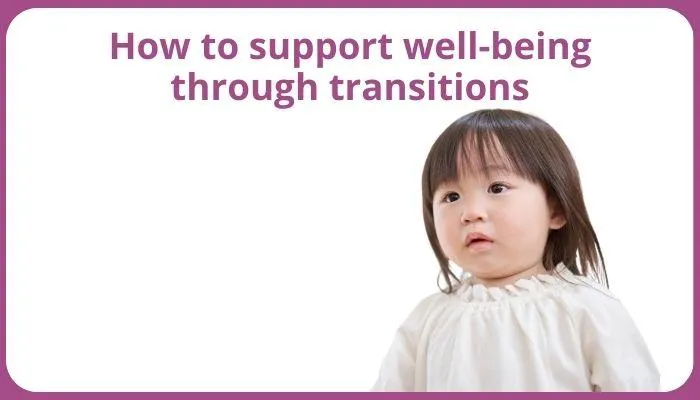Every child's well-being matters.
Well-being Articles

Supporting a child's well-being through transitions
Transitions are an inevitable part of every child’s life, whether it’s starting nursery, moving up to a new room, beginning school, moving house, or even daily changes like coming indoors after playing outside. While some children adapt easily to change, others may find transitions challenging. In early years settings, practitioners play a vital role in helping children navigate these changes with confidence and resilience.
Why Are Transitions Significant for Young Children?
Young children thrive on routine and familiarity, so changes—big or small—can feel unsettling. How children experience and manage transitions can affect their emotional well-being, behaviour, and overall development. Support during these times is crucial to ensure children feel secure and understood.
Common Types of Transitions in the Early Years
Starting nursery or preschool – Being away from familiar caregivers can cause anxiety for many children.
Moving rooms within a setting – New environments and staff can be overwhelming.
Starting school – This significant milestone brings new routines, expectations, and social situations.
Family changes – Moving house, the arrival of a sibling, or parental separation can impact a child’s sense of security.
Daily transitions – Simple changes like tidying up, moving between activities, or coming indoors after outside play can be difficult for some children.
How to Support Children through Transitions
Providing sensitive and thoughtful support can ease the stress associated with transitions. Here are some practical strategies:
Build strong relationships – A secure attachment with a key person helps children feel safe and supported during change.
Prepare children in advance – Use simple language to explain what will happen and when. Visual timetables or social stories can help younger children understand upcoming changes.
Visit new environments – If possible, arrange visits to new rooms or schools so children can become familiar with the setting and staff.
Involve families – Work closely with parents/carers to ensure consistency between home and the setting. Share strategies that work well for the child.
Offer reassurance and patience – Validate children’s feelings and give them time to adjust. Statements like "It’s okay to feel a bit nervous. I’m here to help you." can be comforting.
Use transitional objects – A familiar toy or comfort item can provide security during change.
Create consistent routines – Predictable daily routines help children feel more in control during times of uncertainty.
Provide opportunities for expression – Encourage children to talk, draw, or play to express their feelings about the change.
Supporting Major Life Changes
When transitions involve significant life events, such as family breakdown or bereavement, extra care is needed:
Communicate openly with families to understand the child’s specific needs.
Signpost families to additional support if necessary.
Monitor the child’s well-being and offer one-to-one time when possible.
The Role of Practitioners
Early years practitioners should be proactive in planning for transitions, recognising that even the smallest changes can impact a child’s well-being. By providing consistent support, nurturing relationships, and involving both children and families in the process, we can help children develop resilience and a positive attitude towards change.
Transitions are part of life—but with the right guidance, children can navigate them with confidence and ease.
AUTHOR:- Iona has nearly 10 years of experience supporting nurseries and childminders in curriculum planning, leadership, and safeguarding. Her writing is informed by public information and sector insight, aiming to provide accessible, practical support for professionals working with children. She is part of the On the Button team, helping deliver Well-being, Safeguarding and Complaint Management Software that empowers practitioners to identify concerns early and act confidently.
On the Button provides innovative software tailored to the needs of the early years sector, with a strong focus on EYFS well-being and early years safeguarding. Our tools help senior practitioners to confidently track concerns, maintain robust records, and respond effectively — all while meeting statutory guidance. From early years complaint management to team-wide safeguarding alerts, our platform puts children's safety and emotional health first.

Supporting a child's well-being through transitions
Transitions are an inevitable part of every child’s life, whether it’s starting nursery, moving up to a new room, beginning school, moving house, or even daily changes like coming indoors after playing outside. While some children adapt easily to change, others may find transitions challenging. In early years settings, practitioners play a vital role in helping children navigate these changes with confidence and resilience.
Why Are Transitions Significant for Young Children?
Young children thrive on routine and familiarity, so changes—big or small—can feel unsettling. How children experience and manage transitions can affect their emotional well-being, behaviour, and overall development. Support during these times is crucial to ensure children feel secure and understood.
Common Types of Transitions in the Early Years
Starting nursery or preschool – Being away from familiar caregivers can cause anxiety for many children.
Moving rooms within a setting – New environments and staff can be overwhelming.
Starting school – This significant milestone brings new routines, expectations, and social situations.
Family changes – Moving house, the arrival of a sibling, or parental separation can impact a child’s sense of security.
Daily transitions – Simple changes like tidying up, moving between activities, or coming indoors after outside play can be difficult for some children.
How to Support Children through Transitions
Providing sensitive and thoughtful support can ease the stress associated with transitions. Here are some practical strategies:
Build strong relationships – A secure attachment with a key person helps children feel safe and supported during change.
Prepare children in advance – Use simple language to explain what will happen and when. Visual timetables or social stories can help younger children understand upcoming changes.
Visit new environments – If possible, arrange visits to new rooms or schools so children can become familiar with the setting and staff.
Involve families – Work closely with parents/carers to ensure consistency between home and the setting. Share strategies that work well for the child.
Offer reassurance and patience – Validate children’s feelings and give them time to adjust. Statements like "It’s okay to feel a bit nervous. I’m here to help you." can be comforting.
Use transitional objects – A familiar toy or comfort item can provide security during change.
Create consistent routines – Predictable daily routines help children feel more in control during times of uncertainty.
Provide opportunities for expression – Encourage children to talk, draw, or play to express their feelings about the change.
Supporting Major Life Changes
When transitions involve significant life events, such as family breakdown or bereavement, extra care is needed:
Communicate openly with families to understand the child’s specific needs.
Signpost families to additional support if necessary.
Monitor the child’s well-being and offer one-to-one time when possible.
The Role of Practitioners
Early years practitioners should be proactive in planning for transitions, recognising that even the smallest changes can impact a child’s well-being. By providing consistent support, nurturing relationships, and involving both children and families in the process, we can help children develop resilience and a positive attitude towards change.
Transitions are part of life—but with the right guidance, children can navigate them with confidence and ease.
AUTHOR:- Iona has nearly 10 years of experience supporting nurseries and childminders in curriculum planning, leadership, and safeguarding. Her writing is informed by public information and sector insight, aiming to provide accessible, practical support for professionals working with children. She is part of the On the Button team, helping deliver Well-being, Safeguarding and Complaint Management Software that empowers practitioners to identify concerns early and act confidently.
On the Button provides innovative software tailored to the needs of the early years sector, with a strong focus on EYFS well-being and early years safeguarding. Our tools help senior practitioners to confidently track concerns, maintain robust records, and respond effectively — all while meeting statutory guidance. From early years complaint management to team-wide safeguarding alerts, our platform puts children's safety and emotional health first.

Supporting a child's well-being through transitions
Transitions are an inevitable part of every child’s life, whether it’s starting nursery, moving up to a new room, beginning school, moving house, or even daily changes like coming indoors after playing outside. While some children adapt easily to change, others may find transitions challenging. In early years settings, practitioners play a vital role in helping children navigate these changes with confidence and resilience.
Why Are Transitions Significant for Young Children?
Young children thrive on routine and familiarity, so changes—big or small—can feel unsettling. How children experience and manage transitions can affect their emotional well-being, behaviour, and overall development. Support during these times is crucial to ensure children feel secure and understood.
Common Types of Transitions in the Early Years
Starting nursery or preschool – Being away from familiar caregivers can cause anxiety for many children.
Moving rooms within a setting – New environments and staff can be overwhelming.
Starting school – This significant milestone brings new routines, expectations, and social situations.
Family changes – Moving house, the arrival of a sibling, or parental separation can impact a child’s sense of security.
Daily transitions – Simple changes like tidying up, moving between activities, or coming indoors after outside play can be difficult for some children.
How to Support Children through Transitions
Providing sensitive and thoughtful support can ease the stress associated with transitions. Here are some practical strategies:
Build strong relationships – A secure attachment with a key person helps children feel safe and supported during change.
Prepare children in advance – Use simple language to explain what will happen and when. Visual timetables or social stories can help younger children understand upcoming changes.
Visit new environments – If possible, arrange visits to new rooms or schools so children can become familiar with the setting and staff.
Involve families – Work closely with parents/carers to ensure consistency between home and the setting. Share strategies that work well for the child.
Offer reassurance and patience – Validate children’s feelings and give them time to adjust. Statements like "It’s okay to feel a bit nervous. I’m here to help you." can be comforting.
Use transitional objects – A familiar toy or comfort item can provide security during change.
Create consistent routines – Predictable daily routines help children feel more in control during times of uncertainty.
Provide opportunities for expression – Encourage children to talk, draw, or play to express their feelings about the change.
Supporting Major Life Changes
When transitions involve significant life events, such as family breakdown or bereavement, extra care is needed:
Communicate openly with families to understand the child’s specific needs.
Signpost families to additional support if necessary.
Monitor the child’s well-being and offer one-to-one time when possible.
The Role of Practitioners
Early years practitioners should be proactive in planning for transitions, recognising that even the smallest changes can impact a child’s well-being. By providing consistent support, nurturing relationships, and involving both children and families in the process, we can help children develop resilience and a positive attitude towards change.
Transitions are part of life—but with the right guidance, children can navigate them with confidence and ease.
AUTHOR:- Iona has nearly 10 years of experience supporting nurseries and childminders in curriculum planning, leadership, and safeguarding. Her writing is informed by public information and sector insight, aiming to provide accessible, practical support for professionals working with children. She is part of the On the Button team, helping deliver Well-being, Safeguarding and Complaint Management Software that empowers practitioners to identify concerns early and act confidently.
On the Button provides innovative software tailored to the needs of the early years sector, with a strong focus on EYFS well-being and early years safeguarding. Our tools help senior practitioners to confidently track concerns, maintain robust records, and respond effectively — all while meeting statutory guidance. From early years complaint management to team-wide safeguarding alerts, our platform puts children's safety and emotional health first.

Supporting a child's well-being through transitions
Transitions are an inevitable part of every child’s life, whether it’s starting nursery, moving up to a new room, beginning school, moving house, or even daily changes like coming indoors after playing outside. While some children adapt easily to change, others may find transitions challenging. In early years settings, practitioners play a vital role in helping children navigate these changes with confidence and resilience.
Why Are Transitions Significant for Young Children?
Young children thrive on routine and familiarity, so changes—big or small—can feel unsettling. How children experience and manage transitions can affect their emotional well-being, behaviour, and overall development. Support during these times is crucial to ensure children feel secure and understood.
Common Types of Transitions in the Early Years
Starting nursery or preschool – Being away from familiar caregivers can cause anxiety for many children.
Moving rooms within a setting – New environments and staff can be overwhelming.
Starting school – This significant milestone brings new routines, expectations, and social situations.
Family changes – Moving house, the arrival of a sibling, or parental separation can impact a child’s sense of security.
Daily transitions – Simple changes like tidying up, moving between activities, or coming indoors after outside play can be difficult for some children.
How to Support Children through Transitions
Providing sensitive and thoughtful support can ease the stress associated with transitions. Here are some practical strategies:
Build strong relationships – A secure attachment with a key person helps children feel safe and supported during change.
Prepare children in advance – Use simple language to explain what will happen and when. Visual timetables or social stories can help younger children understand upcoming changes.
Visit new environments – If possible, arrange visits to new rooms or schools so children can become familiar with the setting and staff.
Involve families – Work closely with parents/carers to ensure consistency between home and the setting. Share strategies that work well for the child.
Offer reassurance and patience – Validate children’s feelings and give them time to adjust. Statements like "It’s okay to feel a bit nervous. I’m here to help you." can be comforting.
Use transitional objects – A familiar toy or comfort item can provide security during change.
Create consistent routines – Predictable daily routines help children feel more in control during times of uncertainty.
Provide opportunities for expression – Encourage children to talk, draw, or play to express their feelings about the change.
Supporting Major Life Changes
When transitions involve significant life events, such as family breakdown or bereavement, extra care is needed:
Communicate openly with families to understand the child’s specific needs.
Signpost families to additional support if necessary.
Monitor the child’s well-being and offer one-to-one time when possible.
The Role of Practitioners
Early years practitioners should be proactive in planning for transitions, recognising that even the smallest changes can impact a child’s well-being. By providing consistent support, nurturing relationships, and involving both children and families in the process, we can help children develop resilience and a positive attitude towards change.
Transitions are part of life—but with the right guidance, children can navigate them with confidence and ease.
AUTHOR:- Iona has nearly 10 years of experience supporting nurseries and childminders in curriculum planning, leadership, and safeguarding. Her writing is informed by public information and sector insight, aiming to provide accessible, practical support for professionals working with children. She is part of the On the Button team, helping deliver Well-being, Safeguarding and Complaint Management Software that empowers practitioners to identify concerns early and act confidently.
On the Button provides innovative software tailored to the needs of the early years sector, with a strong focus on EYFS well-being and early years safeguarding. Our tools help senior practitioners to confidently track concerns, maintain robust records, and respond effectively — all while meeting statutory guidance. From early years complaint management to team-wide safeguarding alerts, our platform puts children's safety and emotional health first.




Facebook
Instagram
LinkedIn
Youtube